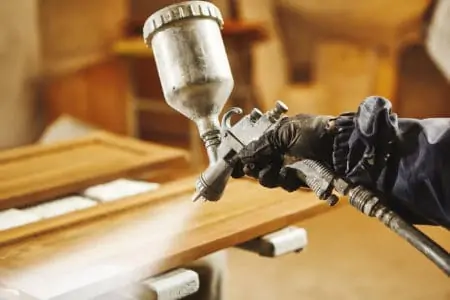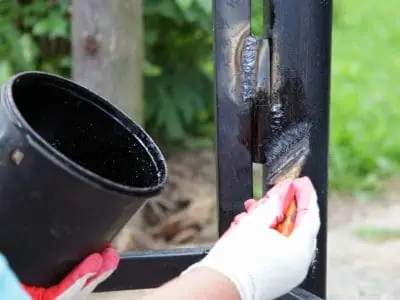What’s the most common problem when painting on any surface? Splatters, drips, and spills on things you don’t want paint on. Oil or latex paint removal can be tricky. It always seems no matter how carefully you tarp an area off; you’ll always get some on the floors or your clothes.
If you’re looking for information on how to remove dried latex paint after these unfortunate but inevitable accidents, then you’ve come to the right place!
Key Takeaways
- Use vinegar, baking soda, or nail polish remover to soften dried latex paint for easier removal.
- For wet latex paint spills, dab and soak with a paper towel and repeat until the paint is removed.
- To remove dried latex paint, use alcohol, nail polish remover, or ammonia on a rag and gently blot the paint until cleaned up.
- Be cautious with chemicals on surfaces like wood or carpet, as they can cause damage if used too vigorously.
Best Latex Paint Removers
- Acetone
- Ammonia
- Krud Kutter® Latex Paint Remover
- Nail Polish Remover
- Vinegar
Will Vinegar or Baking Soda Remove Latex Paint?
The age-old question is, will vinegar or baking soda remove latex paint?
The answer is simple, yes, it can. From floor to ceiling, there are very few surfaces that this solution won’t work for. Though it doesn’t necessarily ‘remove’ the paint, it softens it and thus allows you to easily scrape or peel it off yourself.
Don’t go into this expecting to rub the paint off, as it rarely works out that way.
The trick with baking soda is to add boiling water, then apply the mix (careful it’s hot) to the splatters, spots, and drips. It will soften the paint, allowing for easier clean-up. Give the baking soda 30 minutes to do its work, and then you’re free to finish.
Vinegar is much the same; you just don’t have to heat it. Leave it to rest on the affected area, and in no time, you’ll be cleaning off the paint without damaging the surface underneath.
Will Nail Polish Remover Remove Latex Paint?
Yes, yes it does! Removing latex paint with nail polish remover is one of the most popular choices. This is because the chemicals dissolve that latex without damaging the material underneath. Plus, it’s something commonly found in most people’s bathroom cabinets.
How to Remove Wet Latex Paint
Oh no! You accidentally spilled latex paint, and you need to remove it before it sticks to everything. Have no fear; just follow these easy steps.
- Dab and Soak: Using a paper towel, dab or soak up as much as you can.
- Make It Wet: If there is dried paint, pour some water on it to make it wet again.
- Repeat: Keep repeating the dabbing process until the paint is off your floor.
Caution
While you can use products to help remove the latex paint, it’s important to keep in mind that chemicals are heavier and tend to damage things like carpet or wood if you scrub too vigorously. If the material underneath is starting to look worn down, pause and reconsider your method.
How to Remove Dried Latex Paint
Alright, so you spilled latex paint earlier, and it’s too late for the above steps because the entire spill is dry. Cleaning dried latex paint out of materials and off of surfaces is easy.
- Step 1: Using alcohol, or something similar like nail polish remover or something with ammonia, gently wet a rag.
- Step 2: Set the rag over the spill.
- Step 3: Give it five minutes to react to the latex.
- Step 4: Gently blot up the latex at this point, continuing until it’s thoroughly cleaned up.
As mentioned above, chemicals can damage the surface if left too long or applied too hard.
What You’ll Need
Depending on what you’re trying to get latex paint out of, here are some good things to keep on hand for most materials.
- Acetone
- Ammonia
- Nail Polish Remover
- Vinegar
From Wood
Oops, it looks like you spilled latex paint on your nice wood floors. How should you go about cleaning it up in a way that doesn’t fade the finish or damage the wood? For these situations, reach for the vinegar.
Removing paint from hardwood floors requires some finesse, but you have some room to work because you can always refinish the floor afterward. While you could use heavier chemicals to get the paint from wood, natural options are better as they have less risk of fading.
Refer back to the section on how to remove dry or wet paint and apply that here. Gently set the damp towel over the spill, wait, and dab it until the mess is gone from wood. Viola!
From Concrete Floors
Hallelujah, this is one of the easier surfaces to get latex paint off of. Why, you ask? Because it’s insanely difficult to damage concrete, so you don’t have to worry as much about scrubbing too hard or what chemical you use.
In this case, you can use any of the above options, from acetone to vinegar! I advise the heavier chemicals for this as the water-based paint tends to stick extremely well to stone. Always soak the area beforehand with a wet towel to reduce the amount of scrubbing or dabbing that will be needed.
The key is patience and a good scraper; make sure to keep both on hand.
From Carpets
One thing all homeowners hate to see is paint on carpet, but don’t worry! We’ll help with that. As with all the previous advice, you’ll need a damp cloth to put over it to get latex paint out of the carpet. Lean away from heavier chemicals when possible, as it can cause fading in your carpet.
Take it slow, dab once the latex has begun reacting, and keep at it until your floor is all clean again!
From Enamel Paint
Maybe you’re redoing your bathroom sink with enamel paint and spilled some latex on it. No worries, we have just the fix for you. Soak a cotton ball or a rag in nail polish remover or acetone, and scrub it vigorously.
After a few minutes, pull away and look to see how much progress you’ve made. If it’s not much, you may need to let it rest with chemicals over it before continuing. Continue until clean.
From Brick
Now, as a stark difference to nearly everything else in this article, always use a paint stripper when it comes to brick. Why? Because you don’t want any left behind and paint strippers do this best. There are plenty on the market, so choose what fits your needs.
Soak the brick in a paint stripper and allow it to dry, scrub with a wire brush, and you’re done!
From Metal
If the paint’s already dry, and it’s safe to do so, a paint scraper is my go-to for removing paint from metal. If the paint isn’t dry yet, you can remove most of it with a rag soaked with vinegar or baking soda mixed with hot water.
From Counters
Removing paint from countertops is tricky because it depends on a few factors.
- Is the paint still wet?
- What type of material are your countertops?
- What type of paint is it?
Let’s take a look at a few scenarios and their solutions.
Scenario 1: Wet Paint on Stone Countertops
Stone is usually a porous material, even when sealed. If you spill wet paint on your granite or marble countertops, immediately clot it. Use a material such as kitty litter, flour, or shredded bits of paper.
Once the majority is soaked up, remove the paint-soaked material. Then, using a powdered soap detergent or Borax, clean the remaining stain. Wash, wipe, and repeat until done.
If dealing with oil-based paint, use the tips above. But, in the end, make a paste using cornstarch and water. Cover the stain, allowing the poultice to soak up any oil that may have penetrated the surface, and then wipe away with a cloth and clean water.
Scenario 2: Dried Latex Paint on Stone Countertops
Using small amounts of paint thinner and a paint scraper, gently work the dried paint off the surface without damaging it.
Quick Tip
Use a brand-new razor blade on the scraper to avoid any knicks and scratches.
Once you’re done with either of these scenarios, you’ll likely have to re-seal your stone countertops.
Scenario 3: Wet Paint on Laminate Countertops
Laminate, such as Formica or Wilsonart, is one of the most common types of countertops for kitchens and bathrooms. And, thankfully, it is a pretty durable surface.
To remove wet paint, simply soak up the excess with cat litter, flour, or paper. Remove the soaked material. Then proceed to clean the remainder with a warm soapy water solution.
Scenario 4: Dry Paint on Laminate Countertop
Again, using a paint thinner, cover the dried paint. Let it sit for a few minutes to adhere to the dried material and lift a little from the surface. Then, grab a paint scraper and very gently work it from the countertop. Wipe and wash with warm soapy water.
Quick Tip
Try to use a plastic or acrylic scraper to avoid damaging the laminate.
From Plastic
Latex paint is easy to remove from plastic. As a general rule, all you need is a plastic scraper and time. Patience goes hand-in-hand with that, of course. Gently scrape away the paint until all that’s left is the plastic underneath.
If the paint is still wet, gently wipe it up with a damp paper towel.
From Clothes
This is probably one of the hardest materials to get latex paint out of. To remove it from fabric or out of clothes in general, you’ll want to soak the stain in half detergent and half warm water. Blot it vigorously with a rag or paper towel and continue until the stain is out. This can take some time, so you may want to put on some music to listen to while you work.
From Furniture
Now, this one gets tricky because the term ‘furniture could mean a plastic lawn chair or an expensive wooden headboard. Both require different approaches.
A good rule of thumb for wood furniture is to wipe and clean any wet paint with warm, soapy water. Any remaining paint can be removed using a stripper or thinner. You might have to sand and refinish the spot in the end.
For metal and glass furniture, simply wipe away the paint as usual. If the paint is dry, use a thinner and gently scrape away.
The Verdict
As you can see, latex paint can be a pain to remove from most surfaces, but with patience and the right cleaning agent, you can do it. Always keep an eye on the material you’re removing it from to prevent damaging it by accident.









